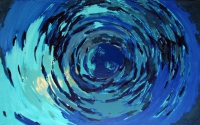Miedzy Nią a naturą.
Malarstwo Edyty Dzierż wywodzi się z polskiej szkoły koloryzmu, co jest niemal oczywiste, jako że artystka studiowała Warszawskiej Akademii Sztuk Pięknych otrzymując dyplom z malarstwa w pracowni prof. Mariana Czapli. Malarstwo dla Artystki stało się Jej powodem, jak sama mówi, do "tworzenia rzeczywisto-abstrakcyjnych płaszczyzn porozumienia" -... miedzy Nią a Naturą, w której istotne egzystencji stanowią wszystkie doznania dramatu i poezji ludzkiego życia,
gdzie obok szczęścia istnieje cierpienie. Jej sztuka uświadamia nam trzy podstawowe pojęcia: przestrzeń, czas i ruch. Drapieżny, pełen energii i kobiecej wrażliwości, kolor płaszczyzny, plam i linii jest wprzęgnięty w sferę symboli, o których pisał niemiecki filozof Schelling, że tworzą prawdziwa sztukę. Nie sposób się z tym nie zgodzić, każdy kolor, każdą formę możemy odczytać jako symbol, ale twórczość Edyty jest twórczością dojrzała i na próżno by szukać w Jej sztuce dosłowności i surrealistycznych przekazów.
Jej natura i pasja tworzenia nie pozwala ograniczyć się do ram obrazu.
Już na studiach szukała wyjścia w przestrzeń znajdując swoje miejsce w pracowniach malarstwa ściennego i rzeźby. A czym jest malarstwo ścienne i rzeźba?
Czy tylko jedna forma wizualnego przedmiotu? Być może jest to odpowiedź dla odbiorcy, ale dla artysty jest to praca, w której zmysł dotyku odgrywa zasadniczą funkcję. Artysta tworzy swoje dzieło w paradoksie świadomości i nieświadomości, jego dzieło staje się rzeczywistością, której sens nie jest nawet dla niego
do końca zrozumiały. Geniusz czasem czerpie z intuicji. Nie bez powodu mówiłem o dotyku i o sprzeczności świadomości artysty. Obrazy Edyty Dzierż
są dowodem tego paradoksu, choć może sama Artystka nie zadawała sobie sprawy jak doniosłą rację przekazuje w swojej twórczości: otóż uświadamia nam,
że obraz oprócz wizualnego oglądu można odebrać dotykiem. Materia obrazu staje się integralną żywą tkanką samego artysty.
Tylko malarstwo Davida Siqueirosa, jednego z trzech wielkich meksykańskich twórców XX wieku, z jego ściennymi muralami i malarstwo Edyty Dzierż jest w stanie pokazać nową, w teorii sztuki malarskiej, drogę twórczości i odbioru.
Jerzy Grochocki
artysta, malarz
_________________
Between her and nature.
The painting of Edyta Dzierż comes from the Polish school of colorism, which is almost obvious, as the artist studied at the Warsaw Academy of Fine Arts, receiving a diploma in painting in the studio of prof. Marian Czapla. Painting for the Artist became her reason, as she says herself, to "create real-abstract planes of understanding" -... between her and Nature, in which all experiences of the drama and poetry of human life constitute essential existence, where beside happiness there is suffering. Her art makes us aware of three basic concepts: space, time and movement. Predatory, full of energy and feminine sensitivity, the color of the plane, spots and lines is embedded in the sphere of symbols that the German philosopher Schelling wrote about as creating real art. It is impossible to disagree with it, every color, every form can be read as a symbol, but Edyta's work is mature and it is in vain to look for literal and surreal messages in her art.
Her nature and passion for creation does not allow her to be limited to the picture frame.
Already during her studies, she was looking for a way out into space, finding her place in wall painting and sculpture studios. What is wall painting and sculpture? Only one form of a visual object? Perhaps this is an answer for the recipient, but for the artist it is a work in which the sense of touch plays an essential function. The artist creates his work in the paradox of consciousness and unconsciousness, his work becomes a reality whose meaning is not even for him fully understandable. Sometimes genius comes from intuition. It was not without reason that I spoke of touch and the contradiction of the artist's consciousness. Paintings of Edyta Dzierż are proof of this paradox, although perhaps the Artist herself did not realize how important she was conveying in her work: that the image, apart from visual inspection, can be perceived by touch. The matter of the painting becomes an integral living tissue of the artist himself.
Only the painting of David Siqueiros, one of the three great Mexican artists of the 20th century, with his wall murals and the painting of Edyta Dzierż is able to show a new, in the theory of painting art, way of creativity and reception.
Jerzy Grochocki, painter.
